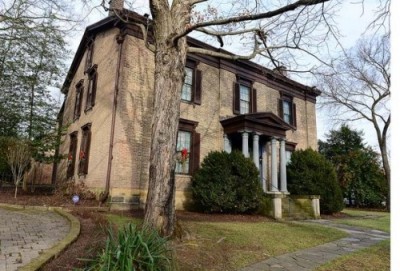Glenwood
Introduction
Text-to-speech Audio
Images
Ellis, Chip. "The Glenwood Estate." http://wvpress.org/. 2013. http://wvpress.org/news/historic-charleston-estate-classroom-marshall-grad-class/.

Backstory and Context
Text-to-speech Audio
James Madison Laidley, a newspaper editor, politician, and prominent salt maker, had this home built in 1852 by William Preston.1 The material used for construction were available on the property or nearby. Wood was cut from the abundant timber standing, bricks were fired from clay found on the property, and the sandstone was taken from a nearby quarry. Brick used in construction is recorded as being 18 inches thick, or the thickness of three bricks.
The exterior of this Greek Revival home is accented with a carved dentil cornice across the front. Sandstone block is used for the foundation.
The Laidley family lived in a smaller four-room brick structure during the construction of Glenwood, This structure became the slave quarters, most likely for domestic slaves. There were smaller, less substantial structures throughout Glenwood's 366 acres for field slaves. Upon completion of the 12-room, two story home, Laidley named the home "Glenwood" for the nearby rock-strewn glen cut by a stream. This was a popular location during the summer for people in the area to visit as it was always cooler in temperature than elsewhere.
In 1857, Judge George Summers purchased Glenwood.2 Summers was an active politician. He served as a representative to the 1850-51 Constitutional Convention in Richmond, ran for governor as a Whig in 1851, and in 1852 became a circuit judge in Kanawha County, a post he held when he purchased Glenwwod. George Summers and his wife, Amacetta, lived at Glenwood until their deaths in 1868 and 1867, respectively.
Sources
1.Cohen, Stan, and Richard Andre. Kanawha County Images: A Bicentennial History, 1788-1988. Charleston, W. Va: Pictorial Histories Pub. Co, 1987. 2."E-WV | Exhibit Section: Glenwood." E-WV | The West Virginia Encyclopedia. Accessed April 28, 2015. http://www.wvencyclopedia.org/sections/182.
